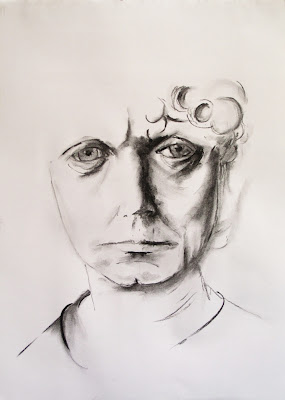 |
| Brett Whiteley, Brett Whiteley fades away, charcoal on paper, 59x42cm |
"there is something unsettling in the way the BWS [Brett Whiteley Studio] is part gallery and part shrine to the memory of man who was once vital, and then faded away."
[blog this art life]
This quote comes from an article on the blog this art life. There is no name attached to the article and the blog has numerous authors, so regrettably i cannot acknowledge the authorship.
The article has an unfortunate smug tone about it. It's not just the use of the royal plural throughout. It's mostly the attempt to gain some critical vantage over BW's work by constructing it as disappointingly dated 1960's hippy effluvia.
Of The American Dream, "we began to feel freaked out, the way people in the 1960s used to get “freaked out”. It was a bad trip, man."
Of Alchemy, "we cannot, however, escape the thought that the work is also horribly dated. Anyone who is sentimental for the mythic past of the 1960s should take a look at this picture to be reminded of the reality – although it was painted in the early 1970s, its hippy concepts are so overwhelming it’s hard to take it seriously."
Negative, even catty, yes. But the writer(s) also seemed to be a person(s) of sensitivity to line and to painted surface. While their tastes and evaluations were not mine they conveyed a clarity of perception, a consistency of perspective, and a sensitivity to atmosphere enough to make me look and think again about Whiteley's work. Certainly enough to make me ponder again about my own response to the Brett Whiteley Studio which I had visited a decade or so ago.
Brett’s studio and home are located in a building that formerly housed a T-shirt factory in Raper Street, Surry Hills, an inner-city suburb of Sydney. He bought it in 1985 and converted it into a studio and exhibition space. He lived in the factory from 1988 until his death in 1992.
 |
| Brett Whiteley Studio by Jac Bowie 2006 |
 |
| Brett Whiteley Studio by Jac Bowie 2006 |
So did i feel, like this author, that "What had troubled us was the deep and inescapable sense of sadness you feel inside the studio. Perhaps it was the ignominious junkie’s death, maybe it was the work that was in a serious state of decline in the last decade of his life."?
I certainly understand what the author meant. Yes, i had the sense that i was walking through the shipwreck of a once proud galleon, now beached, with the tide gone out on its exposed ribs. Yes, i felt sadness hang in the air like stale incense. But that is not all i felt.
For i also witnessed a drawing group in action there. Artists and aspiring artists were gathering around the remains to see if enough energy still wafted through the rooms to energise them too. Or perhaps it was they who were bringing their energy to lay on Brett's shrine.
No, this was not a hippy enclave. It was not the 1970's pickled in a jar. It was a living enterprise. It contained aspiration and inspiration as much as it contained nostalgia and reverence.
| a drawing class at the Brett Whiteley Studio [image link to www.pmmaclism.catholic.edu.au/] |
Our author concludes, "Eventually the sadness was too much to take and we vowed we would never again visit the Brett Whiteley Studio."
But this is not my conclusion. I will return soon, just to unpick the embroidery of my constructions of Brett Whiteley, man and myth, artist and icon.
Meanwhile, i will press on with this series. A few more drawings searching for ideas (but i probably won't post any more of them) and then i'll start on the oil paintings. It may be some time before i post one of those.
So a holiday for some weeks, gentle readers, from Brett Whiteley.
Or rather, Harry Kent's scratchings and scribblings about an enigmatic artist who serves as a window into the enigmatic processes of the creative artist.
.





























+.jpg)









































.jpg)







